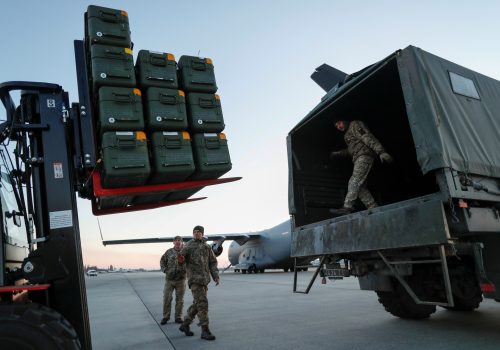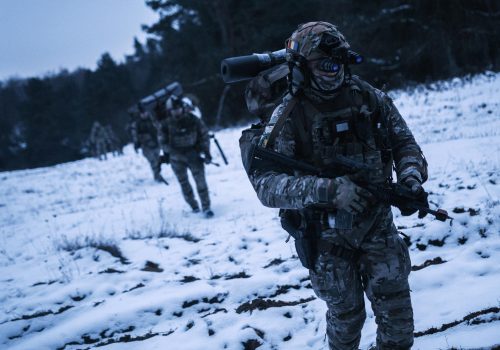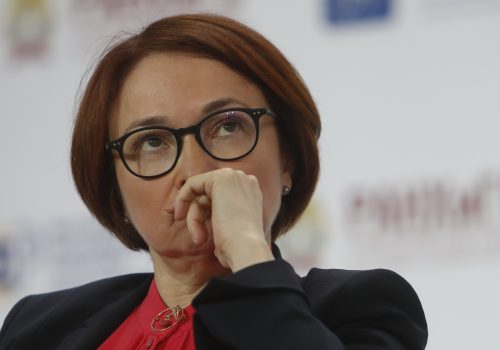How do you track a world transformed? At the Atlantic Council, we’ve set out to answer that urgent question. Ever since Vladimir Putin began massing Russian forces along Ukraine’s border in preparation for his invasion, the United States and its allies have mustered a multifaceted (and in some cases an unprecedented) response. Western nations have rushed humanitarian and military aid to Ukraine, NATO members have dispatched additional forces to the Alliance’s eastern flank, and countries from North America to Europe to Asia have hammered the Russian economy with sanctions. To monitor and visualize these transformative diplomatic, security, and economic actions, teams from across the Atlantic Council have developed the suite of interactive trackers below.
Ukraine aid tracker, presented by the Europe Center
Using open-source information, we are tracking the military and humanitarian support that countries across Europe and North America are providing to Ukraine. Explore our interactive maps below.
Key takeaways
- Opening rush: The biggest wave of aid from the West was sent immediately after Russia began its invasion on February 24. Within the first week, twenty-eight countries sent military aid and twenty-six countries sent humanitarian aid. Since then, aid packages have slowed down and become more spread out over time, but several countries are still sustaining their contributions. For example, fourteen countries sent military aid in the remainder of March, and twenty countries sent military aid in April.
- Geography matters: As many Western countries rushed to prepare aid packages as soon as Russia invaded Ukraine, former Soviet or Warsaw Pact countries on the Eastern front generally responded more quickly and with more robust military aid. Estonia, Latvia, Lithuania, the Czech Republic, and Poland were among the eight countries that had already sent Ukraine lethal military aid in the month before Russia invaded. Balkan countries, including Yugoslavia’s successor states, were less likely to provide military aid, with only three of the seven successor states sending lethal aid.
- Humanitarian politics: Unsurprisingly, there are more Western countries readily sending humanitarian aid than military aid. While some countries wrote off sending any military aid at the beginning of the conflict (e.g., Hungary, Serbia, and Bulgaria), there is widespread support for sending humanitarian aid. Thirty-two countries are providing some form of military aid, while thirty-seven are providing state-sponsored humanitarian aid.
- Comparative advantages: Most countries across the West are doing what they can to support Ukraine, with many relying on their own comparative advantages in choosing what aid to send. For example, Germany, the United Kingdom, and especially the United States are sending military aid packages (both lethal and non-lethal) to Ukraine more often than most other countries. Meanwhile, out of the ten Western countries not sending any military aid, nine have sent humanitarian aid.
- Widespread solidarity: Despite a few countries still refraining from sending certain types of aid, it is clear that the conversation on whether and how to support Ukraine is happening in every capital on both sides of the Atlantic. Within countries, multiple ministries or branches of government are combining efforts to further assist civilians, often in partnership with non-governmental organizations, by gathering and sending humanitarian aid ranging from medicine and food to shelter supplies and rescue equipment to Ukraine. On military assistance, the West stepped up even more as the Ukrainian resistance proved itself. More countries have jumped in to send aid—including lethal aid—as Ukraine’s requests have evolved from defensive weapons towards heavy weapons and artillery.
NATO Forward Forces tracker, presented by the Transatlantic Security Initiative
In the lead-up to Russia’s invasion of Ukraine in February 2022 and particularly since the outbreak of hostilities, the United States and NATO allies have taken numerous steps to bolster allied force posture in Eastern Europe, enhancing deterrence against further Russian aggression and demonstrating the Alliance’s ability to defend its eastern flank. The Scowcroft Center for Strategy and Security’s Transatlantic Security Initiative has been tracking it all, drawing on publicly available information to visualize the changes in the animation, graphs, and table below.
Additional NATO forces deployed to Eastern Europe from February to April 2022
The pre-buildup baseline: A breakdown of NATO forward force deployments in Eastern Europe before February 2022
NATO Forward Forces Tracker
Global Sanctions Dashboard, presented by the GeoEconomics Center
The latest edition of our Global Sanctions Dashboard dives into the various ways the world has targeted Russia with sanctions—and where the gaps are. We have collated all sanctioned entities across Western authorities in a searchable database.
Key takeaways
- Ukraine’s fierce resistance on the battlefield has given sanctions and export controls against Russia the time they need to demonstrate their effects. Financially, Russia is still surviving thanks to energy revenue but it struggles to obtain critical components to continue industrial production.
- Yet in spite of the initial shocks from the West’s deployment of a near-full arsenal of sanctions, the Russian government has made payments to foreign creditors. Moscow has so far avoided sovereign default status on its foreign debt.
- The lifeline of the Russian economy is energy-export revenue, and Moscow will continue to take advantage of Europe’s dependencies on its exports even as the EU looks for alternatives and tries to reduce its dependency on Russia.
-
Russia will earn approximately $321 billion from energy exports in 2022 if current trends continue—funds that help Russia finance its war. But the past months have taught us that the situation can change rapidly and unexpectedly. Russia’s recent unexpected gas cut-offs to Poland and Bulgaria are only likely to increase the EU’s appetite for alternative energy supplies.
- Russia is struggling to obtain critical components to continue industrial production. The well-coordinated multilateral export-control regime against Russia, especially in the tech sector, is beginning to bite. As time goes on, Russia’s inability to obtain components for production promises to degrade its military.
- Western countries have demonstrated an unprecedented level of coordination in their sanctioning of Russia, but they still need to close the gaps. Most Russian entities are sanctioned by single rather than multiple jurisdictions.
- Western jurisdictions are likely to ramp up cyber sanctions against Russia in anticipation of intensified cyberattacks from Moscow.



